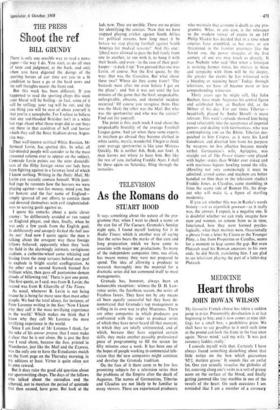Heart throbs
MEDICINE JOHN ROWAN WILSON
My favourite French cheese has taken a sudden jump in price. Presumably devaluation is at last beginning to bite, and it now comes at nine shil- lings for a small box, a prohibitive price. We shall have to say goodbye to it until such time as the pound can look the franc in the face once again. 'Never mind,' said my wifz. 'It was just coronary fodder, really.'
I console myself with that. Certainly I have always found something disturbing about that little notice on the box which guarantees '65% matiere grasse.' It sounds like an awful lot. One can actually visualise the globules of fat, coursing along one's veins as a sort of greasy scum on the surface of the blood, and finally getting jammed like tiny marbles in one of the vessels 'of the heart. On such occasions I am reminded that I am a member of a coronary family, that my father suffered from high blood pressure and my grandfather (a portly man who, like Dr Johnson, had a great fondness for the brown fat on a joint of beef) succumbed to what was then referred to as an apoplexy at the age of fifty-five.
, Whether coronary disease as such is here- ditary, nobody knows. Certainly it is commoner in some families than others. If you have a father or mother who died of a coronary you have twice as much chance of getting one your- self as a person with a negative family history. But this is not necessarily due to a direct physi- cal predisposition. You might inherit a certain kind of temperament, you might be educated by your parents in eating habits similar to their own, or you might inherit a social background and a way of life which puts you, as they say, 'at risk.' This kind of difficulty in evaluating statistics is typical of the studies on coronary heart disease.
There can be few conditions on which we have collected so many facts with so little use- ful result. We know, of course, that diet is im- portant. Black South Africans have a very low incidence of the condition, much lower than either Europeans or coloured Americans. So it is obviously something to do with the circum- stances of life in economically advanced socie- ties. Since coronary disease is associated with fatty deposits in the arteries the evidence is overwhelming that it is in some way associated with the greater consumption of food among western nations.
Exactly what food is still the subject of argu- ment. It may be fats, it may be some particular form of fat, it may be carbohydrate—or it may be all three. Other factors, though not primary causes of coronary diseases, can be shown to increase its incidence and severity. Cigarette smoking quite definitely increases the risk (per- haps by the effect of nicotine, which causes con- traction of the arterial wall) and so does physical inactivity. There is a great difference between the sexes. In women the condition is much less common than in men until about ten years after the menopause. Presumably, there- fore, there must be some hormonal factor in- volved.
But it is all rather vague, and some of the recent studies seem to make the picture more rather than less confused. A study of the health of doctors between 1947 and 1965 showed an increase of incidence of coronaries which occurred almost entirely in the early age-groups, between forty-five and fifty-four. This differs materially from two other series which dealt with insurance salesmen and bus conductors. These two latter groups showed a much greater increase in incidence. It is suggested that the doctors may have done relatively better because they have tended to stop smoking. This is plausible enough. But why should the incidence in doctors be increasing at all? It is hard to believe that their diet has changed very signi- ficantly in the last twenty years. They do not appear to take much less exercise than they did. Surely, if they have cut down their smoking (as I am sure they have) the incidence should be going down? But it isn't. In the age group forty-five to fifty-four it is up by 60 per cent in twenty years.
Still, while it is admitted that our knowledge is incomplete and the general picture of the condition is still baffling us, we might as well do anything we can to ward off such a serious medical emergency. The ideal way, of course, would be to live an energetic life free from worry and anxiety, and confine ourselves to a diet of bananas and tapioca. A complete regime of this kind being impracticable, we have to get as near to it as we can within the framework of our circumstances.
The Americans, resourceful as ever, have started an 'anti-coronary club' designed to en- courage people to adopt an improved way of life. The regime they recommend is a diet which is scientifically designed to cut down calorie intake, total fat, and cholesterol, and which substitutes polyunsaturated fat for satur- ated fat. Cigarettes are prohibited and moderate exercise encouraged. With this routine they claim that the incidence of coronaries can be reduced, providing the patient sticks to it for two years or more. Unfortunately, as with diets for obesity, there is a high tendency to back- slide after the first enthusiasm has worn off.
Perhaps- the most perplexing feature of the whole coronary situation is that the coronary type of man—tense, driving, conscientious, hard-working, and preoccupied with his job to the exclusion of other activities—is precisely the kind of man we are told Britain needs to solve its current problems. Coronaries and economic advancement seem- to be as closely linked together- as silicosis and mining. Perhaps the Government should consider introducing some form of industrial compensation.







































 Previous page
Previous page